Passaic Formation (PA) - All footprints here are from the late Triassic Period (215 mya) from the Passaic Formation. The slabs here are red, blue, brown, and olive-green sandstones which were deposited during the formation of the Newark rift basin. Typical ichnotaxon list: Anchisauripus tuberosus (small to medium sized theropod dinosaur), Apatopus sp. (phytosaur), Atreipus sp. (ornithischian dinosaur), Batrachopus gracilis (crocodylomorph), Brachychirotherium (rauisuchian crurotarsan), Chirotherium lulli (crurotarsan, possibly aetosaurid), Eubrontes giganteus (large theropod dinosaur), Grallator parallelus (small theropod dinosaur), Gwyneddichnium sp. (tanystropheid), Rhynchosauroides sp. (lepidosauromorphs), Procolophonichnium sp. (procolophonid parareptile), and others.
|
Anchisauripus tuberosus
(small to medium sized theropod dinosaur)
 |
 |
please e-mail a photo if you have a print of this type.
|
Apatopus sp.
(phytosaur)
 |
 |
please e-mail a photo if you have a print of this type.
|
Atreipus sp.
(ornithischian dinosaur)
 |
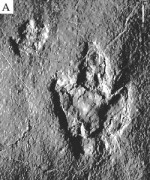
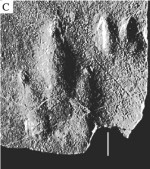 |
1) Atreipus milfordensis manus-pes set from Birdsboro PA (From Szajna and Hartline) Olsen, P.E., 1980a[4].
|
Batrachopus gracilis
(crocodylomorph)
 |
 |
please e-mail a photo if you have a print of this type.
|
Brachychirotherium
(rauisuchian crurotarsan)
 |
 |
| The slab, found in Exeter Township south of Jacksonwald, PA., dates from the late Triassic Period (approximately 200 million years ago). The slab contains two distinct types of fossil footprints: three-toed tracks known as Grallator and five-toed tracks known as Brachychirotherium. The Grallator tracks were made by small to medium-sized carnivorous dinosaurs, walking on two feet. The length of the tracks tells researchers they were made by dinosaurs three to fifteen feet in length. Since many species had similar footprints, it is impossible to be certain which dinosaurs made these prints. Most researchers, however, believe dinosaurs known as Coelurosaurs probably made the tracks, including the Coelophysis in the exhibit. The Brachychirotherium were made by animals walking on four feet. Paleontologists think these prints were made by plant eating reptiles known as Aetosaurs, not by dinosaurs. The meat-eating group known as Rawsuchids, could also have made these tracks. The slab is unique for several reasons. First, it was found within 20,000 years of the Triassic-Jurassic boundary in the very Latest Triassic. It is important because this time interval is very poorly exposed all over the world. Before these tracks were discovered, scientists knew virtually nothing about what was happening during this important time period in continental strata. The slab documents the last appearance of the Triassic fossil footprint Brachychirotherium. This is important because the track is thought to represent two reptile families known from the Late Triassic, Rauisuchids and Stagonolepids.
(Data from http://www.readingpublicmuseum.org/galleries/first/treasure_first/tr_1_natural_science.html)
|
Chirotherium lulli
(crurotarsan, possibly aetosaurid)
 |
 |
1) Chirotherium lulli partial trackway from Birdsboro PA (From Szajna and Hartline) Olsen, P.E., 1980a[4].
|
Eubrontes giganteus
(large theropod dinosaur)
 |
 |
please e-mail a photo if you have a print of this type.
|
Grallator
(small theropod dinosaur)
 |
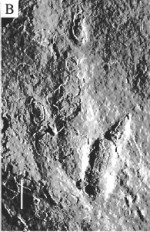
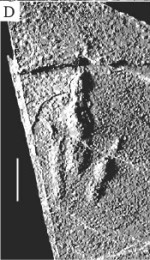
 |
1-2) Grallators from Birdsboro PA (From Szajna and Hartline) Olsen, P.E., 1980a[4]. 3) Refer to description above.
|
Gwyneddichnium sp.
(tanystropheid)
 |
 |
please e-mail a photo if you have a print of this type.
|
Procolophonichnium sp.
(procolophonid parareptile)
 |
 |
please e-mail a photo if you have a print of this type.
|
Rhynchosauroides sp.
(lepidosauromorphs)
 |
 |
1) Rhynchosauroides from Birdsboro PA (From Szajna and Hartline) Olsen, P.E., 1980a[4].
|
unknown compressed print
(medium theropod dinosaur) |
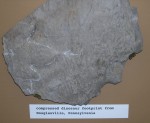 |
1) A footprint compressed by reverse faults or folds caused by continental rifting. Photo from the Rutgers Geology Museum.
|
Other
(ripples, desiccation cracks, etc) |
 |
please e-mail a photo if you have a print of this type.
|


























